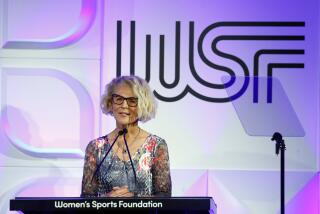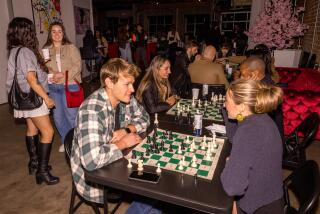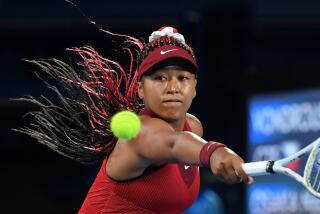A RETURN : Billie Jean King Gives Clinic at Long Beach Courts Where She Learned to Play Tennis
- Share via
LONG BEACH — We see her as a figure in glasses and a white tennis dress, fighting like a tigress on the worn grass of Wimbledon’s Centre Court.
It is a frozen image of the past that the present, try as it may, can never quite crack.
Billie Jean King, 44, returned last weekend to give a clinic and play a little tennis at the hometown courts on which she grew up. The white dress had been replaced by a sweat shirt and warm-up pants that failed to completely hide the bulky consequences of more than three years away from the professional tour.
But she still wore glasses and fought for every point with the same dexterity and fire that won 20 Wimbledon titles and a fabled 1973 battle-of-the-sexes victory over Bobby Riggs.
And she was still revered by those who came to the Billie Jean Moffitt King Tennis Center at 10th Street and Park Avenue.
“I don’t get to play now, and I love to play,” lamented King, whose life as a promoter of Domino Pizza Team Tennis national recreational leagues consists largely of riding airplanes and eating hotel food.
Especially glad that King was back were her parents, Bill and Betty Moffitt, who have lived in the same house on West 36th Street for more than 40 years.
Played Other Sports
As they walked with her into the center that was named for her in 1968, Bill Moffitt recalled: “She was always a good athlete. She played softball and could run, throw and hit like a boy.”
And Betty Moffitt, whose hair is as white as her blouse, said, “To me, she’s the same kid, a good person with her feet on the ground.”
Among the spectators who filled the center’s stands on a windy, brilliant afternoon was Louise Walker, 81, the widow of Clyde Walker, a city Parks Department instructor who taught King to play tennis in the mid-1950s.
She held one of King’s rackets and remembered, “She’d stay at the courts all day long and Clyde would bring her home.”
King, who lives in Chicago, was introduced as the “first lady of tennis” and began playing an exhibition mixed doubles match. She kept her warm-up pants on and wore a microphone around her neck.
She entertained with a running monologue and joked that the state of her body kept her from moving like she once did.
“Come on, B.J.,” a fan shouted as King came up too slowly to return a short shot.
Burst of Finesse
But before long, she hit a backhand volley that rocketed down the center of the court between her opponents. And then, as court-side speakers amplified her gasps, she reached up and smashed another winner.
“I don’t get to play (much) anymore,” she said. “But I’m getting there. I’m getting warmed up.”
The fans laughed and cheered and King’s father, watching from the stands, said, “She’s a ham.”
When King made a bad shot, she yelled in dismay like she always did.
“I still get exasperated at this game,” she said, looking toward the sky.
Soon, though, she rejoiced in another victory, only a couple of courts away from where she won her first tournament 33 years ago.
In 1955, when she was 12, King started playing tennis.
“I started showing up every day at the different parks,” King said in an interview Saturday before her clinic. “(Clyde Walker) started looking at me like, ‘Are you back again?’ I’d say, ‘Yeah, let’s go.’ He knew he had a live one.”
King realized after her first lesson that tennis would be her life: “I knew then I wanted to be the best,” she said. “I could have cared less about being famous; I just wanted to be the best.”
She remembered her first racket.
“I had to earn the money for it. My mom and dad wouldn’t buy it for me. They believe in hard work.”
When King had saved $8, the Moffitts, who did not play tennis themselves, let their daughter buy the racket. It was lavender.
Before the Boom
There was little interest in tennis then, long before the sport’s boom in the 1970s. King’s classmates at Poly High School could never figure out why she played the sport.
“They thought it was crazy,” said King, who won her first Wimbledon doubles title in 1961 as a 17-year-old Poly senior and who 10 years later became the first woman to earn more than $100,000 in a season. “No one understood what I was trying to do, even my teachers. I was never allowed to miss any school for tennis--and I was getting really good grades too. I didn’t think it was fair for basketball players to miss school and I couldn’t.
“I told the principal: ‘You don’t understand what tennis is going to do for me. I’m going to be able to travel, I’m going to help change tennis.’ He just looked at me.”
“Vibrant” is how longtime tennis pro John Lloyd, who had played in the exhibition match, described King as he watched her instruct long lines of youngsters and adults on how to hit a tennis ball.
For more than an hour, King--who was No. 1 in the world before Chris Evert and Martina Navratilova--ran from one side of the court to the other, giving enthusiastic pointers and passionate praise. Balls flew everywhere. “Thumps” from mis-hits cluttered the air. But occasionally, a perfect “pock” would echo upon contact between ball and strings.
As a promoter of the team tennis leagues, King is concerned about today’s recreational player. King said the number of tennis players in the country has dropped by 40% since 1979. To rekindle interest, she travels thousands of miles a year, putting on exhibitions and clinics in the hope that people will join a league.
When the clinic ended, King and her parents gathered under a tree for a photograph. She giggled when she talked with them as if indeed she were a kid again. She held her first trophy--1955 Long Beach Class D Singles--which Bill Moffitt had found a few days earlier in the garage.
“I felt I was on my way (when I won it),” King said. “I was so happy because Clyde was so happy. You just know when people believe in you. That’s what children need.”
Past Is Behind Her
Four hours after she had arrived, King remained at the center to sign autographs and pose for snapshots.
She had emphasized in the earlier interview that she does not live in the past--”I know a couple of athletes who still talk about when they won Wimbledon. Nobody cares. I don’t expect them to care.”
But she was wrong.
Clinic participants Angie Wilson and Mary Ann Boyd watched as a Polaroid image of them and their idol materialized.
“It’s exciting when you’ve watched Wimbledon for years and here she is big as life and so down to earth,” Wilson said.
A man on a bicycle, who said she was his favorite athlete, told King: “How about putting on there, ‘To Fritz, my favorite doubles partner.’ ”
Familiar Ruddy Face
Off to the side, Bill Moffitt, who for 37 years drove fire trucks for the city, watched his daughter. Her familiar full face was reddened by wind. At the corners of her eyes were tiny lines etched by years of smiling and squinting up to hit overheads.
“People are very demanding,” Moffitt said. “That one family took up 10 minutes. I hope it doesn’t kill her. But as long as she’s happy.”
The Moffitts, whose son, Randy, is a former major league pitcher who lives in Georgia, were looking forward to some private time with their daughter. When she was playing, they were lucky to see her once a year. Now they get to see her several times a year.
“We’ll have a nice breakfast at the house tomorrow, and she’ll probably call her brother,” King’s father said.
He knew, though, that by 1 in the afternoon she would be gone again.
More to Read
Go beyond the scoreboard
Get the latest on L.A.'s teams in the daily Sports Report newsletter.
You may occasionally receive promotional content from the Los Angeles Times.










